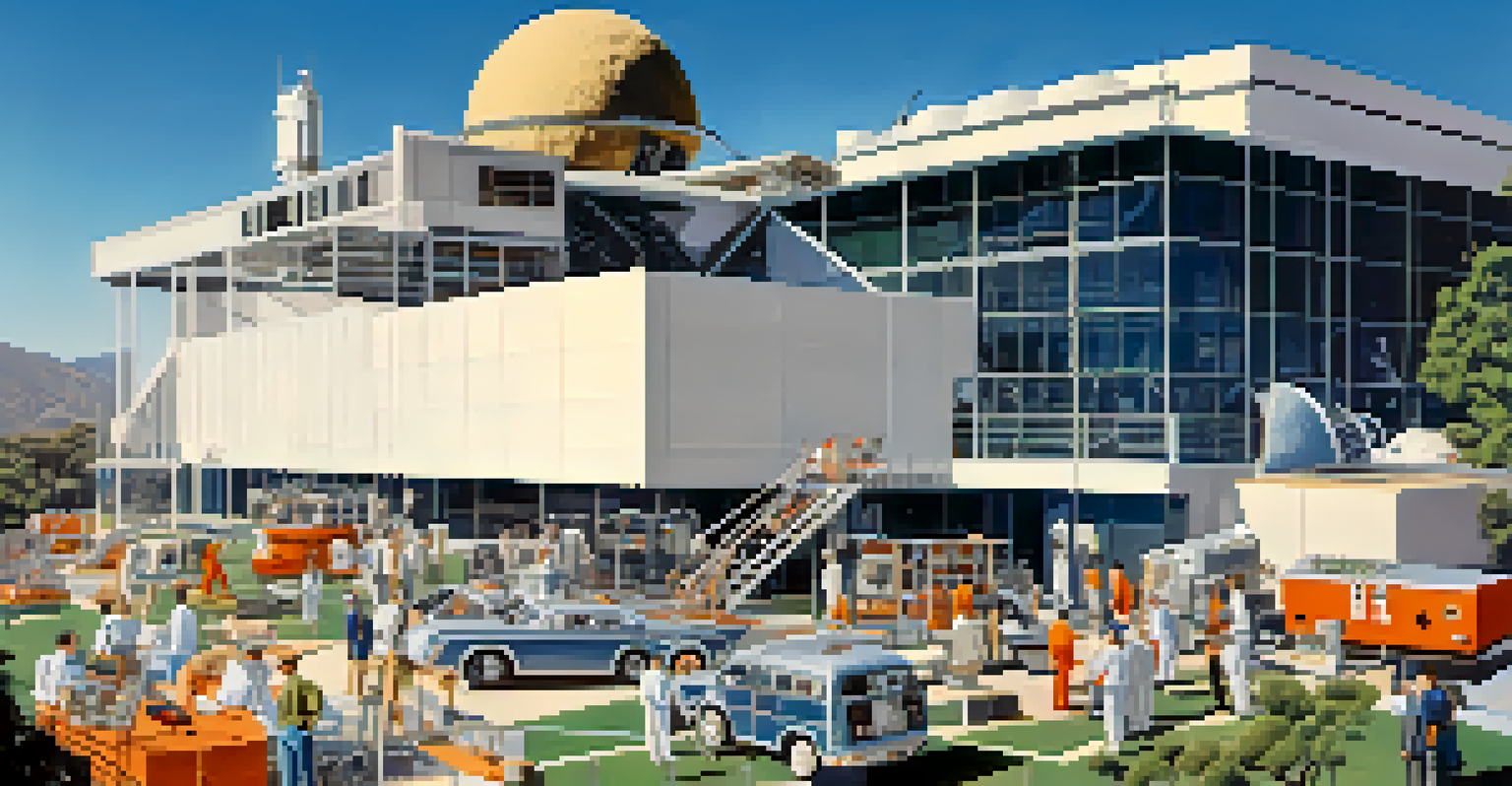California's Space Industry: A Historical Overview and Impact

The Birth of California's Space Industry in the 1940s
California's space industry began taking shape in the 1940s, driven by World War II and the subsequent Cold War. The state became a focal point for aerospace development, with companies like Lockheed Martin and Northrop Grumman emerging as key players. These companies laid the groundwork for future innovations by developing advanced technologies that would later be adapted for space exploration.
The Earth is the cradle of humanity, but mankind cannot stay in the cradle forever.
As the demand for military aircraft surged, California's aerospace sector attracted talented engineers and scientists, transforming the region into a hub of innovation. The collaboration between government entities and private firms played a pivotal role in this growth, fostering an environment ripe for experimentation and discovery. This period set the stage for the ambitious space missions that would follow in the coming decades.
The establishment of the Jet Propulsion Laboratory (JPL) in Pasadena in 1944 marked a significant milestone, as it facilitated the transition from military aerospace to space exploration. JPL became synonymous with groundbreaking projects like the Mars rovers and Voyager missions, showcasing California's ability to lead in the space race.
The Space Race: California's Role in Global Competition
The 1960s witnessed an intense competition known as the Space Race, primarily between the United States and the Soviet Union. California played a crucial role during this period, with NASA's establishment of the Ames Research Center and the continued expansion of JPL. These institutions not only contributed to technological advancements but also became symbols of American ingenuity on the global stage.

One of the most significant achievements was the Apollo program, which aimed to land a man on the Moon. California engineers and scientists were instrumental in developing the necessary technologies and systems, including the Lunar Module. This landmark success not only showcased California's capabilities but also inspired a generation to pursue careers in science and engineering.
California's Space Industry Origins
California's space industry emerged in the 1940s, fueled by World War II and the Cold War, with key players like Lockheed Martin and Northrop Grumman paving the way for future innovations.
The excitement surrounding the Space Race helped to galvanize public interest in space exploration, leading to increased funding and support for various projects. This momentum solidified California's position as a leader in the industry, with countless innovations stemming from research conducted in the state.
The Rise of Commercial Space Ventures in the 2000s
As the 21st century dawned, California's space industry began to shift towards commercialization. Companies like SpaceX and Blue Origin emerged, transforming the landscape of space travel and exploration. These private enterprises not only aimed to reduce costs but also to make space more accessible to the average person, fostering a new era of innovation and competition.
That's one small step for [a] man, one giant leap for mankind.
SpaceX, founded by Elon Musk in 2002, has become a household name, revolutionizing satellite launches and cargo missions to the International Space Station (ISS). Their reusable rocket technology has significantly changed the economics of space travel, making it feasible for a broader range of missions. This paradigm shift has encouraged other startups to enter the field, creating a vibrant ecosystem of innovation in California.
This transition towards commercial space ventures has also led to increased collaboration between government agencies and private companies. Programs like NASA's Commercial Crew Program have further solidified this partnership, enabling the development of new technologies and fostering a culture of shared success within the industry.
California's Impact on Space Exploration Technologies
California's contributions to space exploration technologies are vast and varied, influencing everything from satellite design to propulsion systems. The state's research institutions, such as Stanford University and the California Institute of Technology, have played a vital role in pioneering new technologies that push the boundaries of what is possible in space travel.
For instance, California-based companies have made significant advancements in satellite technology, enabling improved communication, Earth observation, and global positioning systems (GPS). These innovations have not only transformed how we explore space but also how we navigate and communicate on Earth, demonstrating the interconnectedness of advancements in aerospace.
Commercial Ventures Transform Space
The rise of companies like SpaceX and Blue Origin in the 2000s has shifted California's space industry towards commercialization, making space more accessible and fostering a culture of innovation.
Moreover, California's focus on developing sustainable technologies has positioned the state at the forefront of the growing field of space sustainability. Initiatives aimed at reducing space debris and promoting responsible exploration practices are gaining traction, highlighting California's commitment to a sustainable future in space.
Educational Institutions and Their Contributions
California is home to some of the world's leading educational institutions that have made significant contributions to the space industry. Schools like Stanford, UC Berkeley, and Caltech have produced countless engineers, scientists, and researchers who have gone on to make impactful strides in aerospace. These institutions foster a culture of innovation and collaboration, often partnering with industry leaders to tackle complex challenges.
Programs focused on aerospace engineering and astrophysics not only equip students with the necessary skills but also encourage hands-on experience through internships and research projects. This practical approach ensures that graduates are well-prepared to enter the competitive field of space exploration. The emphasis on interdisciplinary studies also promotes a broader understanding of the challenges and opportunities within the industry.
Additionally, initiatives such as NASA's Space Grant Program provide funding and resources for students to engage in space-related research. These investments in education are vital for the continued growth of California's space industry, ensuring a steady pipeline of talent and ideas that will shape the future of exploration.
California's Space Industry and Climate Research
The convergence of California's space industry and climate research is a prime example of how space technology can address pressing global challenges. Satellite missions launched from California have provided invaluable data for studying climate change, natural disasters, and environmental monitoring. This information is crucial for understanding our planet and making informed decisions regarding sustainability and conservation efforts.
Institutions like JPL have been at the forefront of developing satellites that monitor Earth's climate systems, such as the GRACE and SMAP missions. These projects help scientists track changes in water resources, greenhouse gas emissions, and land use, offering insights that are vital for policymakers and researchers alike. California's unique position as a leader in both space exploration and environmental science has made it a focal point for addressing climate issues.
California's Role in Climate Research
California's space technology advancements are crucial for climate research, providing vital data for environmental monitoring and reinforcing the state's leadership in addressing global challenges.
Furthermore, partnerships between private companies and research organizations are enhancing these efforts. By leveraging advanced technologies and innovative approaches, California's space industry continues to contribute to our understanding of climate change, fostering a collaborative spirit that benefits both the industry and the planet.
Looking Ahead: The Future of California's Space Industry
As we look to the future, California's space industry is poised for continued growth and innovation. With ongoing advancements in technology and an expanding array of commercial space ventures, the state remains a global leader in aerospace. The potential for new missions, including Mars colonization and asteroid mining, presents exciting opportunities for entrepreneurs and researchers alike.
The emphasis on sustainable practices and international collaboration is also likely to shape the future of the industry. As countries come together to tackle shared challenges in space exploration, California's expertise will play a critical role in driving these initiatives forward. This collaborative approach fosters a spirit of unity that extends beyond borders, emphasizing the importance of cooperation in achieving ambitious goals.

Moreover, the growing interest in space tourism and the potential for extraterrestrial habitation are creating new markets and possibilities. California's innovative spirit, coupled with its rich history in space exploration, positions the state as a beacon of inspiration for future generations eager to explore the final frontier.